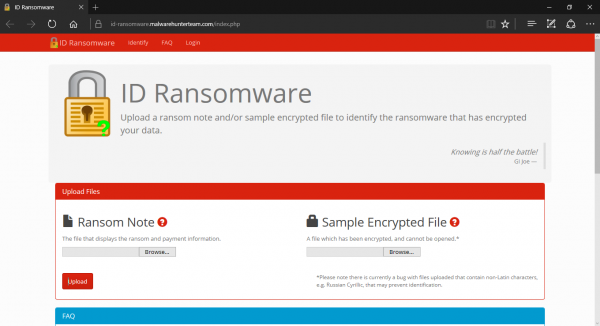Ransomware is a major problem computer users have encountered in recent years. Unlike regular malware or viruses, they may damage system files or slow down your internet connection. These infections are more dangerous because they lock your data and demand money to unlock it. If your beloved computer is infected by ransomware, it will likely block the user from accessing a section of their computer. If the user wants to gain access, they must pay. A user’s computer is held hostage by hackers, and they demand a ransom to set it free.
How do you check for and tell if you have ransomware? Well, if your computer is infected, you will not be able to open your files as they might have been encrypted. Plus, you will receive a ransom note demanding payment. How do you identify the ransomware by name? ID Ransomware is a free online service that will identify the Ransomware that has infected your Windows PC. It currently detects 52 different ransomware.

How to Identify Ransomware which has infected computer
Although you may take the normal precautions to prevent ransomware, you never know when you could be hit. Unlike real life hostage situations, there’s no negotiation here, either pay up or do without being able to access important files.
To tackle this ransomware issue, there’s a website that goes by the name, ID Ransomware. It doesn’t clear a computer system of ransomware, but it can help the user detect what type of ransomware they are dealing with to gain further help elsewhere.
Simply locate the ransom note and upload it to the website via the Ransom Note section. Furthermore, it is also possible to upload encrypted files via the option on the right-hand side of the webpage.
Bear in mind that ID Ransomware is not capable of decrypting files. Users will be required to find an alternative or seek out a professional. We understand that ID Ransomware can detect up to 54 infections, which is quite a lot considering ransomware is not widespread.
Here’s a list of what ID Ransomware website can currently detect:
777, 7ev3n, 7h9r, 8lock8, ACCDFISA v2.0, Alfa, Alma Locker, Alpha, AMBA, Apocalypse, Apocalypse (Unavailable), ApocalypseVM, AutoLocky, AxCrypter, BadBlock, Bandarchor, BankAccountSummary, Bart, Bart v2.0, BitCrypt, BitCrypt 2.0, BitCryptor, BitMessage, BitStak, Black Feather, Black Shades, Blocatto, Booyah, Brazilian Ransomware, Bucbi, BuyUnlockCode, Cerber, Cerber 2.0, Cerber 3.0, Chimera, Coin Locker, CoinVault, Coverton, Cryakl, CryFile, CryLocker, CrypMic, Crypren, Crypt0, Crypt0L0cker, Crypt38, CryptFuck, CryptInfinite, CryptoDefense, CryptoFinancial, CryptoFortress, CryptoHasYou, CryptoHitman, CryptoJoker, CryptoMix, CryptorBit, CryptoRoger, CryptoShocker, CryptoTorLocker, CryptoWall 2.0, CryptoWall 3.0, CryptoWall 4.0, CryptXXX, CryptXXX 2.0, CryptXXX 3.0, CryptXXX 4.0, CryPy, CrySiS, CTB-Faker, CTB-Locker, DEDCryptor, DirtyDecrypt, DMA Locker, DMA Locker 3.0, DMA Locker 4.0, Domino, ECLR Ransomware, EduCrypt, El Polocker, Encryptor RaaS, Enigma, Fabiansomware, Fantom, FenixLocker, Flyper, GhostCrypt, Globe, Gomasom, Herbst, Hi Buddy!, HolyCrypt, HydraCrypt, Jager, Jigsaw, JobCrypter, JokeFromMars, JuicyLemon, KawaiiLocker, KeRanger, KEYHolder, KimcilWare, Kozy.Jozy, KratosCrypt, Kriptovor, KryptoLocker, LeChiffre, LockLock, Locky ransomware, Lortok, Magic, Maktub Locker, MirCop, MireWare, Mischa, Mobef, n1n1n1, NanoLocker, NegozI, Nemucod, Nemucod-7z, NullByte, ODCODC, OMG! Ransomcrypt, PadCrypt, PayForNature, PClock, Philadelphia, PowerLocky, PowerWare, Protected Ransomware, R980, RAA-SEP, Radamant, Radamant v2.1, RansomCuck, RarVault, Razy, REKTLocker, RemindMe, Rokku, Russian EDA2, SamSam, Sanction, Satana, ShinoLocker, Shujin, Simple_Encoder, Smrss32, SNSLocker, Sport, Stampado, SuperCrypt, Surprise, SZFLocker, Team XRat, TeslaCrypt 0.x, TeslaCrypt 2.x, TeslaCrypt 3.0, TeslaCrypt 4.0, TowerWeb, ToxCrypt, Troldesh, TrueCrypter, UCCU, UmbreCrypt, UnblockUPC, Unlock92, Unlock92 2.0, Uyari, VaultCrypt, VenusLocker, WildFire Locker, WonderCrypter, Xorist, Xort, XRTN, zCrypt, ZimbraCryptor, Zyklon, etc.
For those who might be wondering, yes, your data uploaded to the ID Ransomware website is confidential, well, according to the website itself. We can’t vouch for it, so folks will just have to them by their word.
Overall, a solid service that works well. However, seeing as it works in the browser, an internet connection will always be needed, so we’re hoping an offline version will be released in the future.
How do I know if I am infected with ransomware?
Detecting a system that is infected with ransomware is pretty straightforward. You won’t be able to open or access any file or folder locked by ransomware. On the other hand, you will get a message saying that your files have been locked and you need to pay a ransom to unlock them.
Can you detect ransomware?
Yes, it is possible to detect ransomware if your PC is infected by it. Multiple tools and websites can help you recognize the name or type of ransomware. You can check out the ID Ransomware website, which is free, easy to use, and handy for quickly detecting ransomware.
You can also use Bitdefender Ransomware Recognition Tool to help you identify Ransomware and see if a Ransomware Decryptor is available.
if you have ransomware and your computer locked
meaning windows,can you format windows or sit it in your hard drive ?
Formatting the computer will usually completely get rid of the ransomware. that is why backups are important to protect yourself from this type of malware.
thank you.i ask this to call frad help desk they did t answer me,so fair only was some one hacked in to mi bank account,never got ransormware,thank you
It’s easy to get scared and people often are much more willing to pay for ransom then to prevent it from infecting your PC. I’ve never had this issues, started with antivirus but now with ransomware getting much stronger and smarter people need to be aware that only antivirus is not always going to help you. I would recommend for all of you guys Impedio Security. It’s not only antivirus, it’s security software with shields created exactly for ransomware. They scan and look for threats all day long so it’s always updated and you don’t need to worry that some new kind of ransomware will attack, Impedio got this covered!